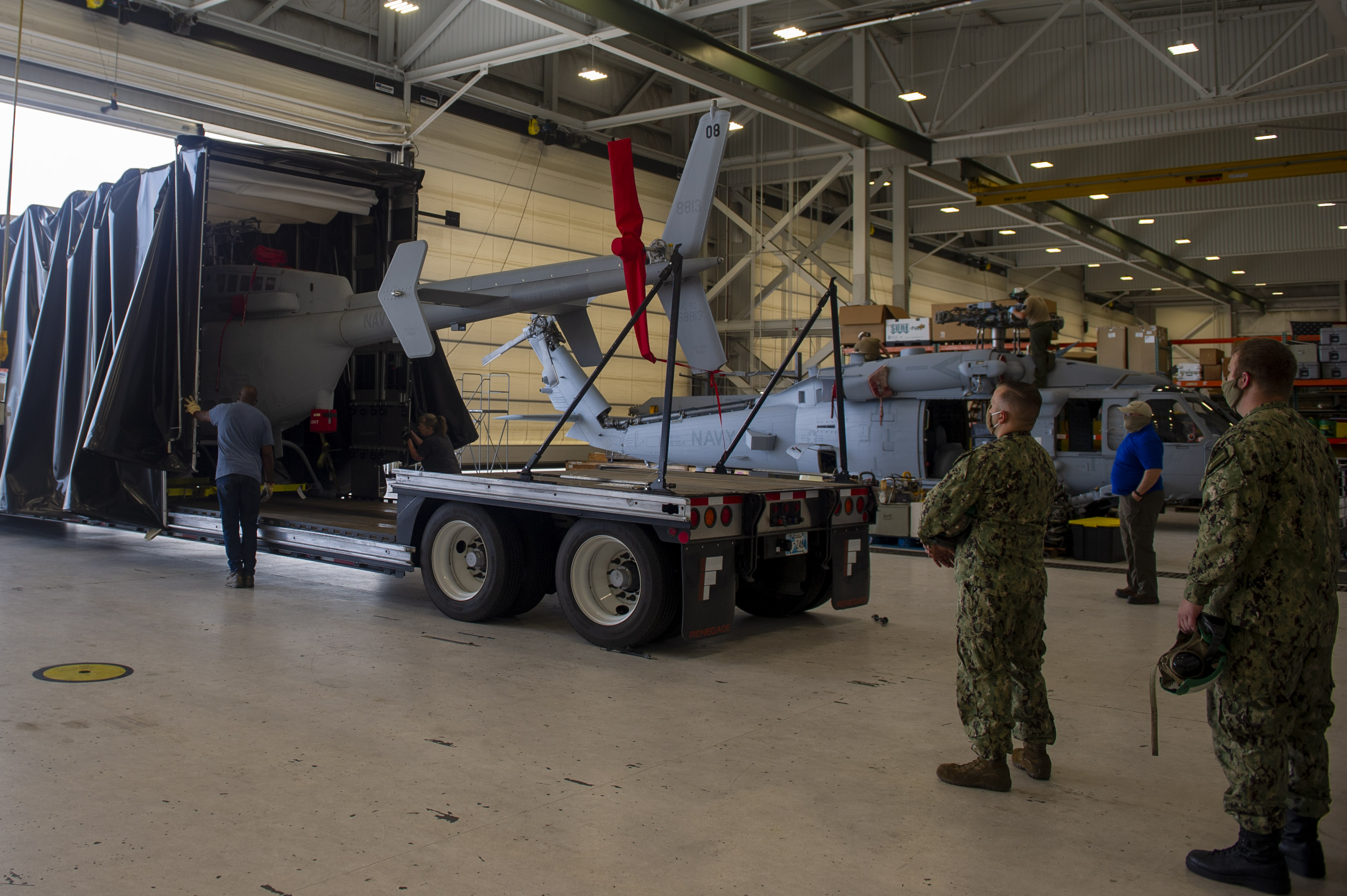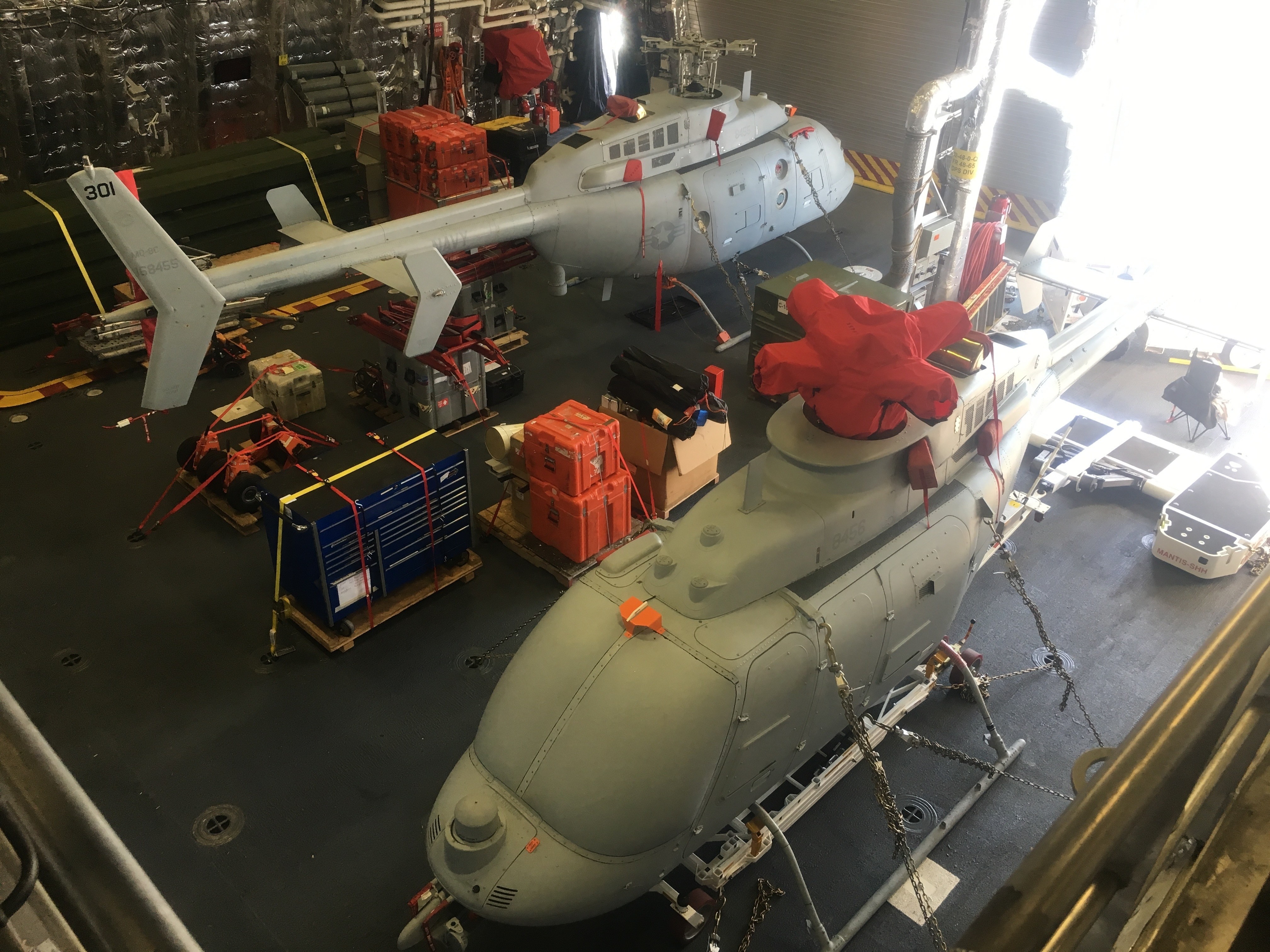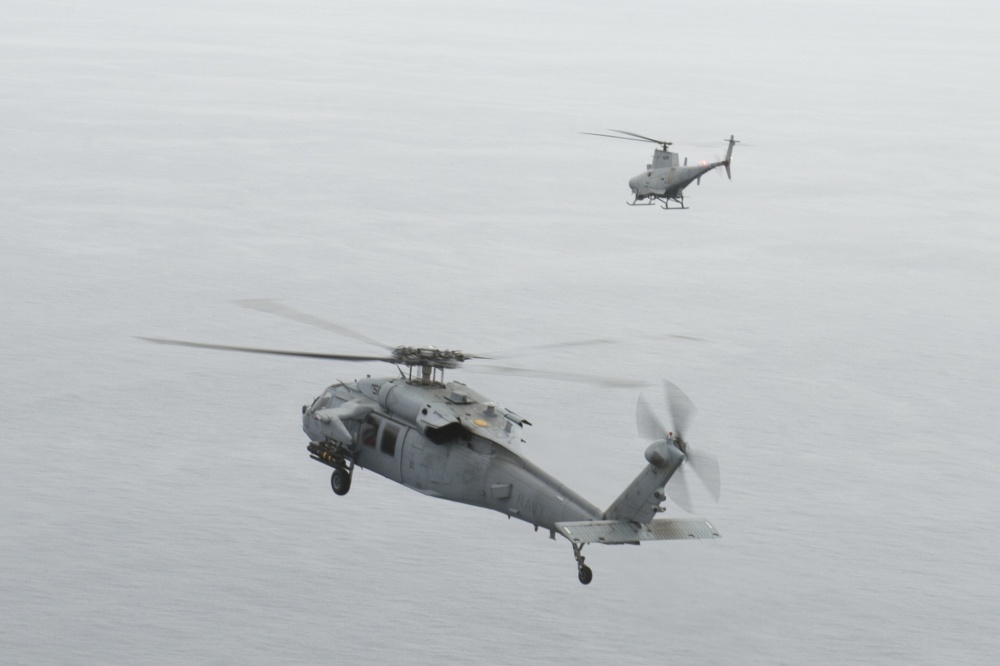
The Navy is getting closer to operating the new and larger MQ-8C Fire Scout variant on its Littoral Combat Ships, with two squadrons taking possession of their first aircraft and working towards safe-for-flight certification.
Helicopter Sea Combat Squadron (HSC) 22 received its first MQ-8C Fire Scout on Sept. 15, making it the first East Coast unit to begin working with the aircraft that features more than twice the endurance and 50-percent greater speeds than the MQ-8B variant, which first saw operations aboard LCS in 2015.
Cmdr. Matthew Wright, HSC-22’s commanding officer, told USNI News that his squadron has been working on manned/unmanned teaming between their MH-60S Knighthawks and the MQ-8B for the past year. This newest vehicle is their third Fire Scout overall and first Charlie variant in the inventory.
“It’s significantly more capable: basically does all the things that the Bravo, the older version, does, but significantly better,” he said.
“It’s bigger and it’s faster and it’s stronger, honestly. It can stay airborne more than twice as long, which is a big deal for unmanned vehicles. And it can have more persistence on a battlefield. Whereas the Bravo version is pretty good, the Charlie is much better. It can go faster, and it can carry a lot more sensors,” including an improved radar than can find more contacts in the water than the older system.
HSC-22 is primarily focused on sending detachments to serve onboard LCSs as part of the surface warfare mission package, though the squadron has also supported operations off USS Wasp (LHD-1) recently. A recent deployment aboard USS Detroit (LCS-7) gave the squadron an extended opportunity to work out a lot of details, including how to launch both the MH-60 and the Fire Scout from the flight deck at the same time for certain missions, or how to stagger them most effectively during other kinds of missions.
“We’ve really pushed the envelope on flying simultaneously off a single spot on a ship, both manned and unmanned. It takes a lot of planning, it takes a lot of practice, but you can get both airborne at the same time, and they’re very complementary as far as what they bring to a variety of missions,” Wright said.

While continuing to learn more about the MQ-8B and how to get the most out of that platform, the squadron will now start learning how to maintain and operate the larger MQ-8C, Wright said.
Ahead of a first deployment with the Charlie variant next year, the maintainers are getting their hands of the vehicle in the hangar now, after having gone through schoolhouse training only so far. The squadron’s first step will be to achieve the safe-for-flight certification, which means the squadron can conduct MQ-8C operations on its own without the supervision of Naval Air Systems Command or test squadrons that have already worked more extensively with the air frame. Once the squadron is allowed to operate independently, it will take the Charlie vehicle to Wallops Island, Va., for land-based operations before heading out to an LCS and conducting training and pre-deployment workups.
Wright said his squadron has a lot on its plate, having to operate and maintain one manned helicopter and essentially two different unmanned helicopters. But he also said he thought they had an operational advantage by pairing the manned and unmanned aircraft at the squadron level, which is something not done with all other unmanned craft.
Unlike many other squadrons, Wright said, “our people do both manned and unmanned. The same pilots fly both manned and unmanned – one day they can be flying the H-60, another day they can be flying the Fire Scout. So we’ve learned how to train up both operators and maintainers to do that and do them well.”
The pilots fly both, either in the cockpit of the H-60 or in a console flying the Fire Scout. Other air crew might serve as a rescue swimmer in the H-60 one day and then operate the Fire Scout payloads the next day. And, of course, the maintainers have to be able to keep now all three air frames in top readiness.
“We have all the traditional training programs still in place; my H-60 pilots are just as qualified as any other squadron’s H-60 pilots. And in reality, it’s not quite as hard for pilots as you might think: if you’re doing a surface search, if you’re doing a search and rescue, if you’re doing an SUW mission, how you do that mission is pretty much the same in a lot of ways, whether you’re sitting in a console or sitting in a cockpit. So the training there is very complementary,” he said, noting that a schoolhouse sits just down the street from his squadron’s hangar and that it takes about five weeks to train a pilot to fly the Fire Scout.
“A lot of times, what may or may not be overlooked is the maintainers: these are two completely different platforms, and my maintainers maintain both Fire Scout and MH-60, and we’re learning now to maintain a completely different Fire Scout (with the Charlie variant), if you look at it from a nuts and bolts perspective. There’s some redundancy, but it’s a new airframe, it’s significantly bigger,” he added.

In addition to adding a third Fire Scout to the inventory, Wright said the squadron is also accepting more H-60s, too.
“We’re actually going to actually gain a few manned aircraft, since we’re supporting a lot more LCS detachments. We’ve gained some more personnel, and we just train them all up,” he said when asked how the squadron was managing the greater workload by bringing in more unmanned aerial vehicles.
Despite the greater workload and the additional training needed, Wright said he’s very pleased the Navy has kept the H-60s and the Fire Scouts in the same squadron. Rather than a manned squadron and an unmanned squadron fighting for a piece of a mission, or fighting for flight deck or hangar space – and forcing a ship commander or other outside officer to make a final decision – a single squadron and a single commanding officer can make decisions to balance the best of what the H-60 and the Fire Scout bring to the fight.
“We understand both, and we’re able to optimize both in a way that might not be done as efficiently if you had two separate units … kind of fighting for territory or operational resources,” he said. For example, if the squadron has to conduct a search and rescue for a person in the water, they can decide when to launch both airframes with the understanding of how each would perform based on weather and lighting conditions, what the endurance limitations of each are, and how to best craft a mission that maximizes each platforms’ capabilities.
Naval Air Force Atlantic spokeswoman Cmdr. Jennifer Cragg told USNI News that one squadron on each coast has received the MQ-8C and are working to reach safe for flight. Additionally, she said, “there are currently six MQ-8B Fire Scout variants assigned to two East Coast Helicopter Sea Combat squadrons and eight MQ-8B Fire Scout variants assigned to two West Coast Helicopter Sea Combat squadrons.”
As for being the East Coast squadron tasked with leading the way on the Charlie variant, Wright said it’s “pretty fun to be able to experiment and develop tactics, techniques and procedures that future generations will use.”





